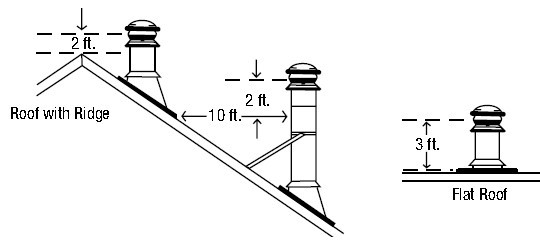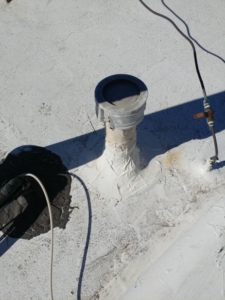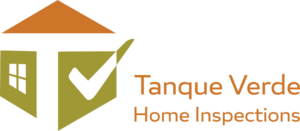Chimney Height
On many of the homes that I inspect, I find the chimney/flue height appears to be too low. A chimney can be your typical fireplace chimney or it can be a vent for a gas appliance such as a furnace or water heater. This can be a safety issue for multiple reasons.
- A taller chimney/flue helps produce a better draft for the hot gases to properly exit the chimney. A chimney that is too short can allow gases/smoke to go back into the house (back-drafting).
- In the case of a fireplace chimney, the taller chimney helps reduce the risk of roof materials or roof debris catching fire from a spark or burning ember. A chimney spark arrestor should also be installed on the chimney to help prevent this from happening.
- If a nearby HVAC appliance (e.g. swamp cooler) is running, it could pull in the carbon monoxide gases from the chimney/flue and push them into the house’s air.
Requirements
A chimney should be 3 feet above the roof and 2 feet above any point within 10 feet (diagram above). Some flues can be shorter. For example a 12-inch diameter or smaller B-vent can be 1-foot above the roof deck. However, a 12-inch diameter or larger B-vent or an L-vent should be 2-feet above the roof and 2-feet above any point withing 10-feet. Other factors may require these heights be raised. L-vents and B-vents are metal flues rated to handle high temperature gases (570 degrees F and 480 degrees F respectively).
In the case of the example image below, the local gas company technician, when they came to turn on the gas, disabled the water heater until the vent could be raised to a proper and safe height.
A home inspector may call out the height of a flue even if it meets the manufacturer’s recommendations. A qualified contractor may then be brought in to agree or disagree with the home inspector’s recommendation. This is done out for safety and may be considered an upgrade rather than a defect needing correction.
Please call Tanque Verde Home Inspections at 520-462-8844 or follow this link to schedule your inspection.



